display YAMAHA VXR 2012 Owners Manual
[x] Cancel search | Manufacturer: YAMAHA, Model Year: 2012, Model line: VXR, Model: YAMAHA VXR 2012Pages: 98, PDF Size: 5.46 MB
Page 5 of 98
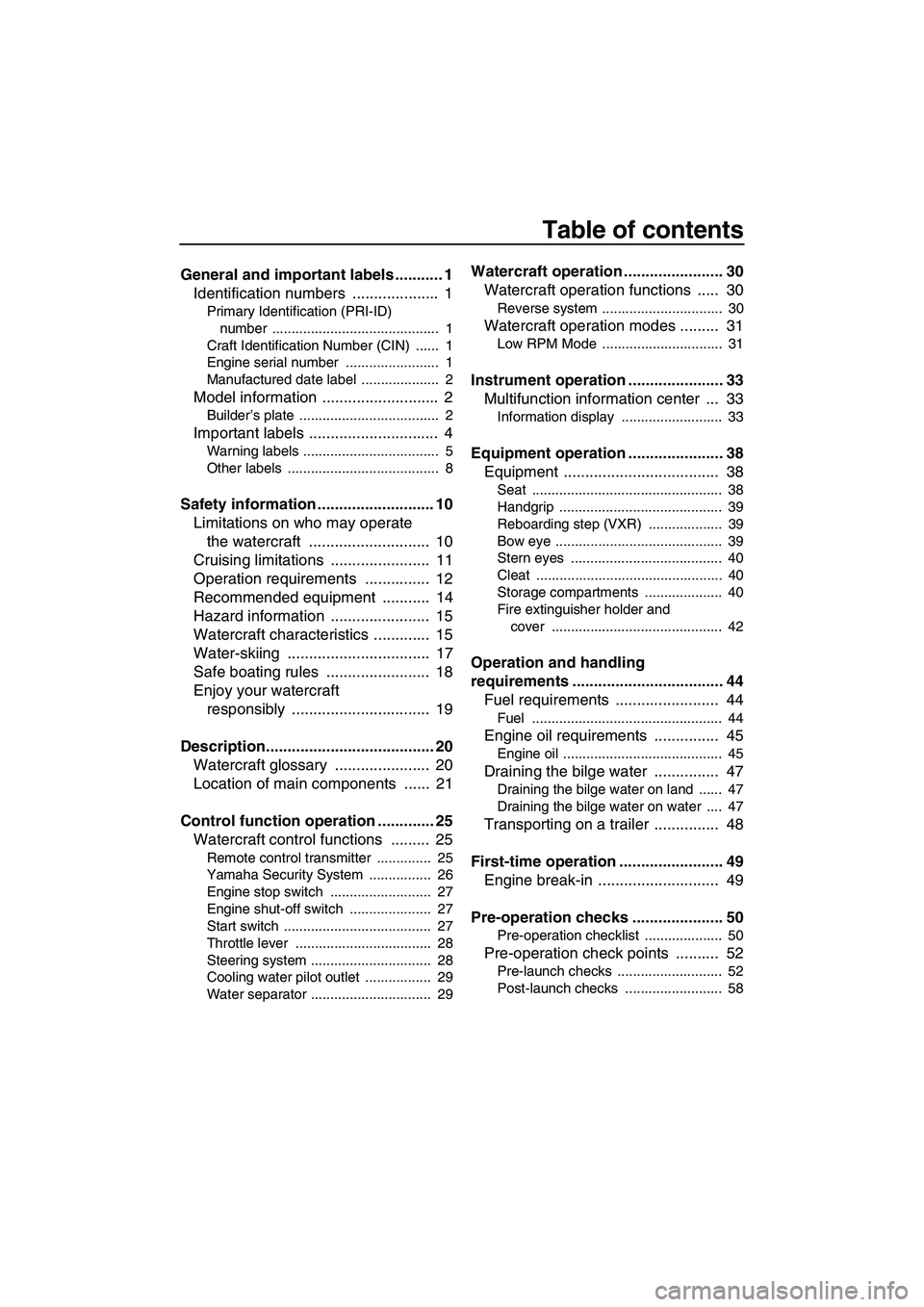
Table of contents
General and important labels ........... 1
Identification numbers .................... 1
Primary Identification (PRI-ID)
number ........................................... 1
Craft Identification Number (CIN) ...... 1
Engine serial number ........................ 1
Manufactured date label .................... 2
Model information ........................... 2
Builder’s plate .................................... 2
Important labels .............................. 4
Warning labels ................................... 5
Other labels ....................................... 8
Safety information ........................... 10
Limitations on who may operate
the watercraft ............................ 10
Cruising limitations ....................... 11
Operation requirements ............... 12
Recommended equipment ........... 14
Hazard information ....................... 15
Watercraft characteristics ............. 15
Water-skiing ................................. 17
Safe boating rules ........................ 18
Enjoy your watercraft
responsibly ................................ 19
Description....................................... 20
Watercraft glossary ...................... 20
Location of main components ...... 21
Control function operation ............. 25
Watercraft control functions ......... 25
Remote control transmitter .............. 25
Yamaha Security System ................ 26
Engine stop switch .......................... 27
Engine shut-off switch ..................... 27
Start switch ...................................... 27
Throttle lever ................................... 28
Steering system ............................... 28
Cooling water pilot outlet ................. 29
Water separator ............................... 29
Watercraft operation ....................... 30
Watercraft operation functions ..... 30
Reverse system ............................... 30
Watercraft operation modes ......... 31
Low RPM Mode ............................... 31
Instrument operation ...................... 33
Multifunction information center ... 33
Information display .......................... 33
Equipment operation ...................... 38
Equipment .................................... 38
Seat ................................................. 38
Handgrip .......................................... 39
Reboarding step (VXR) ................... 39
Bow eye ........................................... 39
Stern eyes ....................................... 40
Cleat ................................................ 40
Storage compartments .................... 40
Fire extinguisher holder and
cover ............................................ 42
Operation and handling
requirements ................................... 44
Fuel requirements ........................ 44
Fuel ................................................. 44
Engine oil requirements ............... 45
Engine oil ......................................... 45
Draining the bilge water ............... 47
Draining the bilge water on land ...... 47
Draining the bilge water on water .... 47
Transporting on a trailer ............... 48
First-time operation ........................ 49
Engine break-in ............................ 49
Pre-operation checks ..................... 50
Pre-operation checklist .................... 50
Pre-operation check points .......... 52
Pre-launch checks ........................... 52
Post-launch checks ......................... 58
UF2M71E0.book Page 1 Wednesday, June 29, 2011 9:27 AM
Page 37 of 98
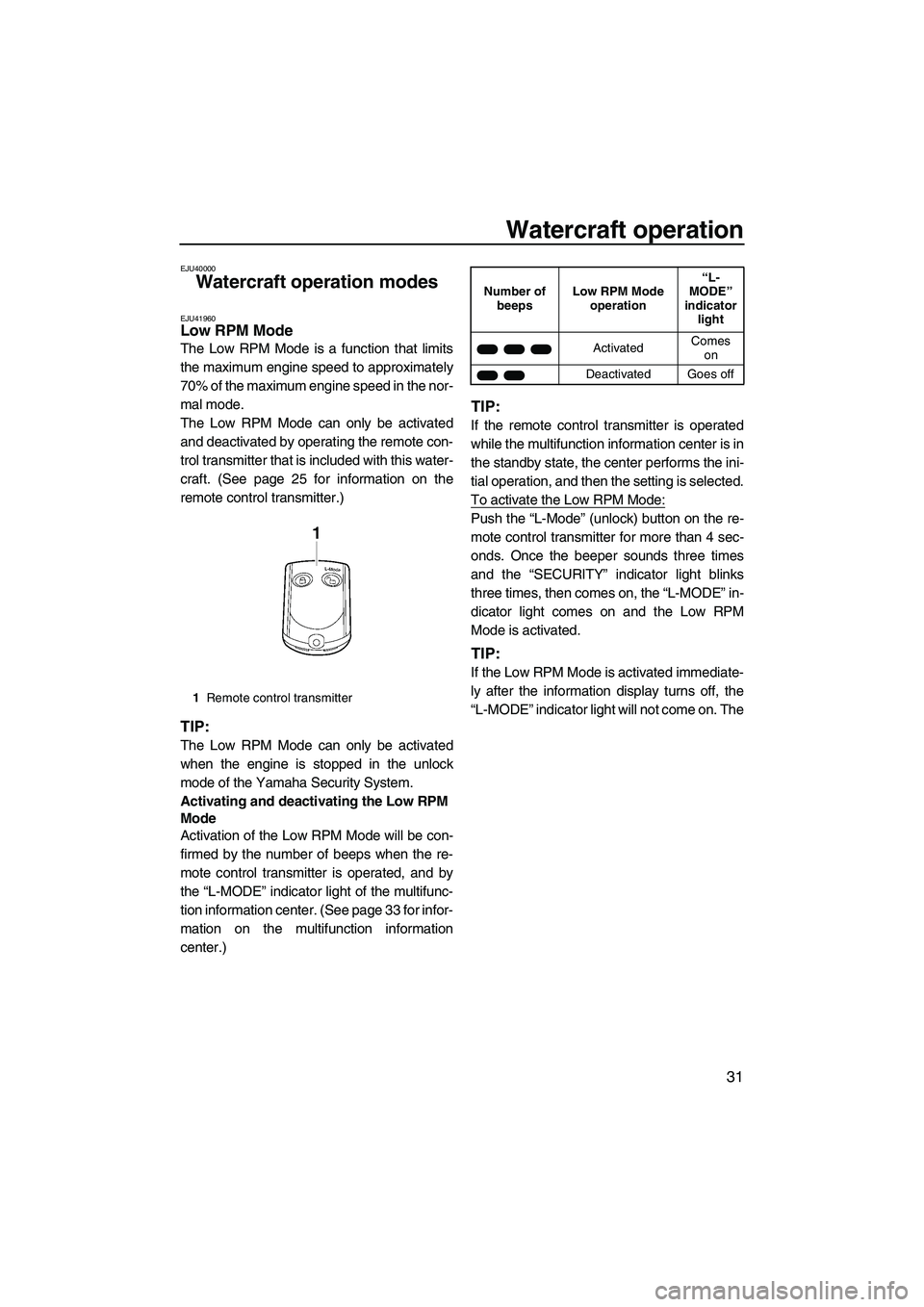
Watercraft operation
31
EJU40000
Watercraft operation modes
EJU41960Low RPM Mode
The Low RPM Mode is a function that limits
the maximum engine speed to approximately
70% of the maximum engine speed in the nor-
mal mode.
The Low RPM Mode can only be activated
and deactivated by operating the remote con-
trol transmitter that is included with this water-
craft. (See page 25 for information on the
remote control transmitter.)
TIP:
The Low RPM Mode can only be activated
when the engine is stopped in the unlock
mode of the Yamaha Security System.
Activating and deactivating the Low RPM
Mode
Activation of the Low RPM Mode will be con-
firmed by the number of beeps when the re-
mote control transmitter is operated, and by
the “L-MODE” indicator light of the multifunc-
tion information center. (See page 33 for infor-
mation on the multifunction information
center.)
TIP:
If the remote control transmitter is operated
while the multifunction information center is in
the standby state, the center performs the ini-
tial operation, and then the setting is selected.
To activate the Low RPM Mode:
Push the “L-Mode” (unlock) button on the re-
mote control transmitter for more than 4 sec-
onds. Once the beeper sounds three times
and the “SECURITY” indicator light blinks
three times, then comes on, the “L-MODE” in-
dicator light comes on and the Low RPM
Mode is activated.
TIP:
If the Low RPM Mode is activated immediate-
ly after the information display turns off, the
“L-MODE” indicator light will not come on. The
1Remote control transmitter
Number of
beepsLow RPM Mode
operation“L-
MODE”
indicator
light
ActivatedComes
on
Deactivated Goes off
UF2M71E0.book Page 31 Wednesday, June 29, 2011 9:27 AM
Page 39 of 98
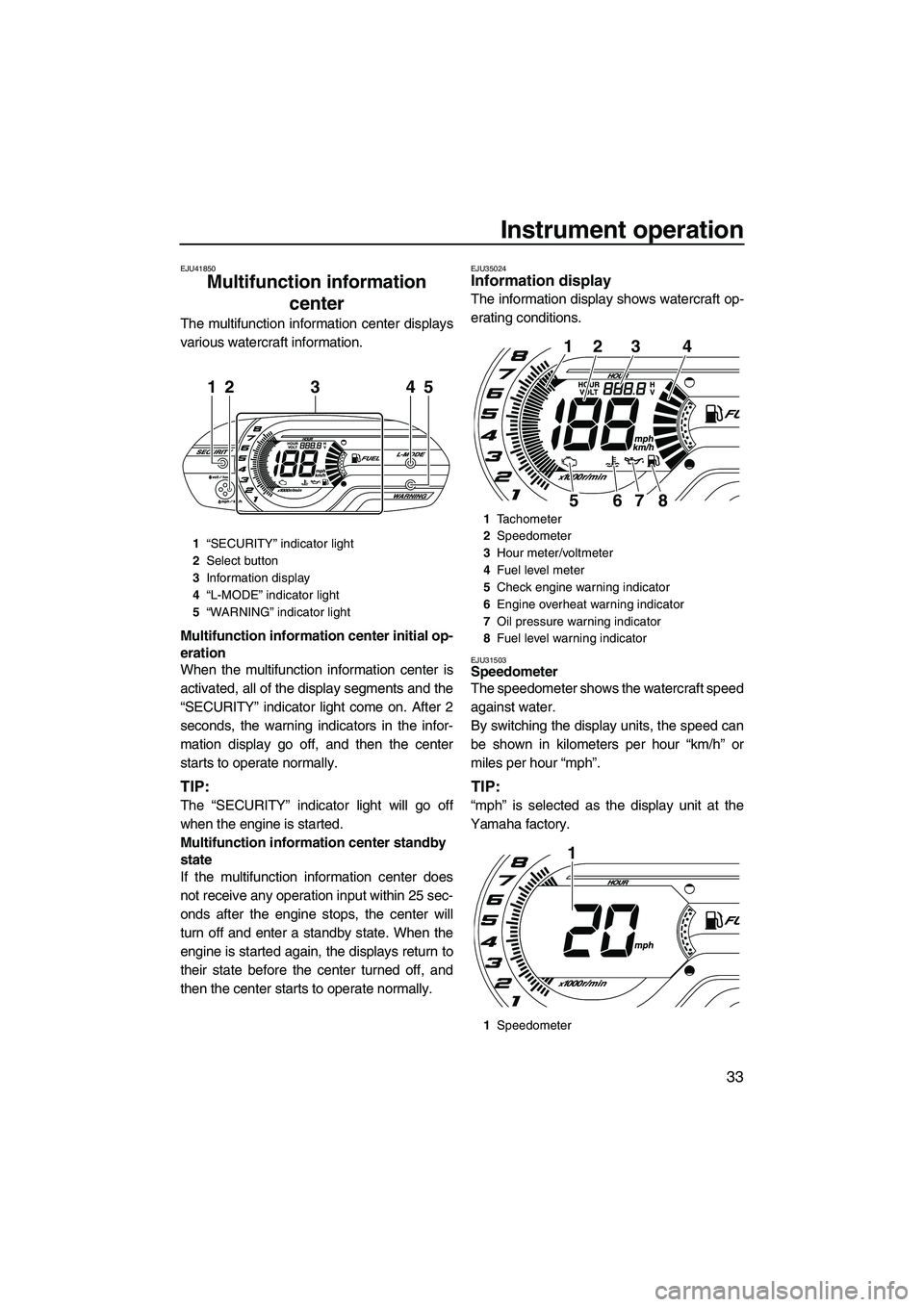
Instrument operation
33
EJU41850
Multifunction information
center
The multifunction information center displays
various watercraft information.
Multifunction information center initial op-
eration
When the multifunction information center is
activated, all of the display segments and the
“SECURITY” indicator light come on. After 2
seconds, the warning indicators in the infor-
mation display go off, and then the center
starts to operate normally.
TIP:
The “SECURITY” indicator light will go off
when the engine is started.
Multifunction information center standby
state
If the multifunction information center does
not receive any operation input within 25 sec-
onds after the engine stops, the center will
turn off and enter a standby state. When the
engine is started again, the displays return to
their state before the center turned off, and
then the center starts to operate normally.
EJU35024Information display
The information display shows watercraft op-
erating conditions.
EJU31503Speedometer
The speedometer shows the watercraft speed
against water.
By switching the display units, the speed can
be shown in kilometers per hour “km/h” or
miles per hour “mph”.
TIP:
“mph” is selected as the display unit at the
Yamaha factory.
1“SECURITY” indicator light
2Select button
3Information display
4“L-MODE” indicator light
5“WARNING” indicator light
21345
1Tachometer
2Speedometer
3Hour meter/voltmeter
4Fuel level meter
5Check engine warning indicator
6Engine overheat warning indicator
7Oil pressure warning indicator
8Fuel level warning indicator
1Speedometer
1234
8765
1
UF2M71E0.book Page 33 Wednesday, June 29, 2011 9:27 AM
Page 40 of 98
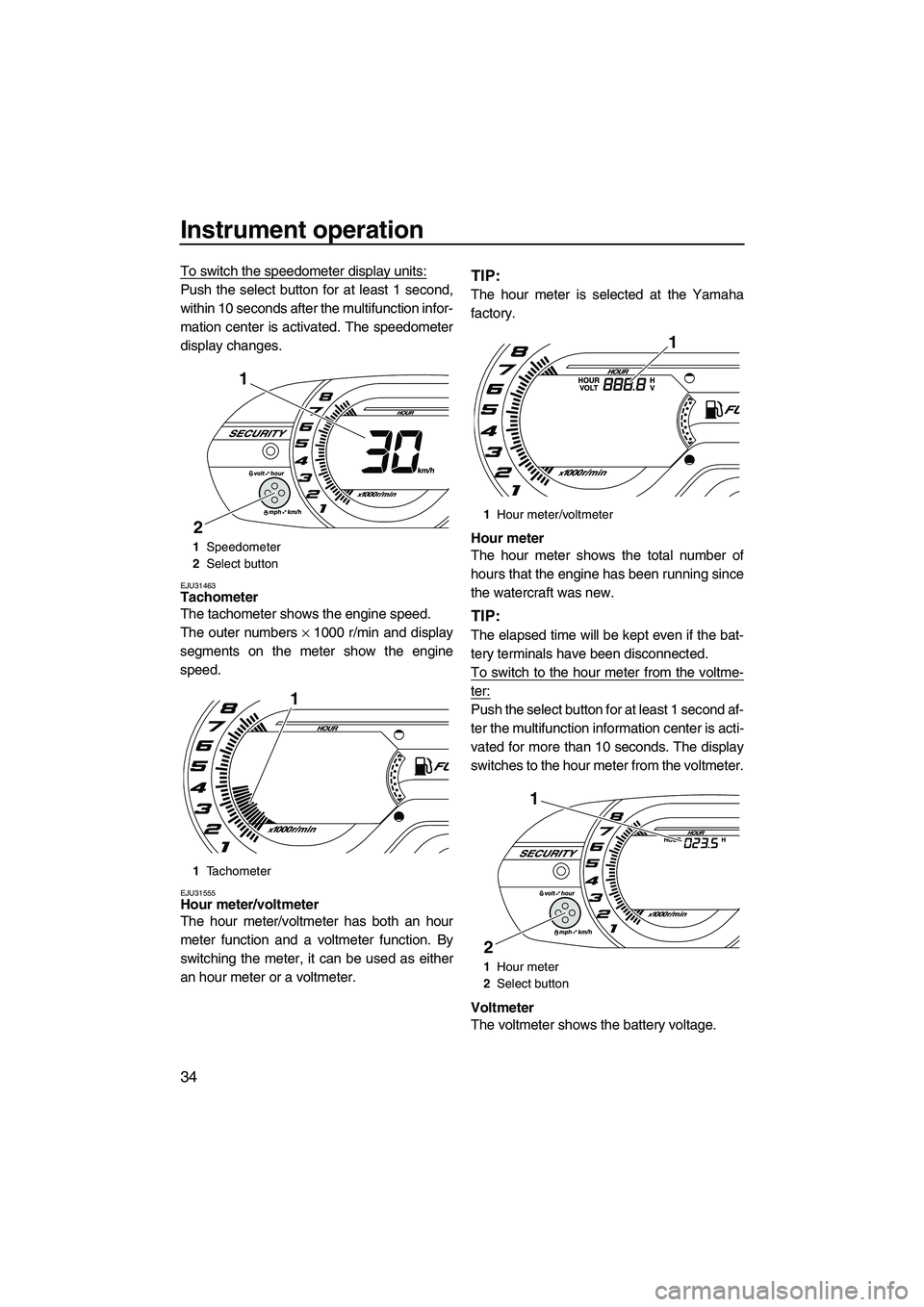
Instrument operation
34
To switch the speedometer display units:
Push the select button for at least 1 second,
within 10 seconds after the multifunction infor-
mation center is activated. The speedometer
display changes.
EJU31463Tachometer
The tachometer shows the engine speed.
The outer numbers × 1000 r/min and display
segments on the meter show the engine
speed.
EJU31555Hour meter/voltmeter
The hour meter/voltmeter has both an hour
meter function and a voltmeter function. By
switching the meter, it can be used as either
an hour meter or a voltmeter.
TIP:
The hour meter is selected at the Yamaha
factory.
Hour meter
The hour meter shows the total number of
hours that the engine has been running since
the watercraft was new.
TIP:
The elapsed time will be kept even if the bat-
tery terminals have been disconnected.
To switch to the hour meter from the voltme-
ter:
Push the select button for at least 1 second af-
ter the multifunction information center is acti-
vated for more than 10 seconds. The display
switches to the hour meter from the voltmeter.
Voltmeter
The voltmeter shows the battery voltage.
1Speedometer
2Select button
1Tachometer
1
2
1
1Hour meter/voltmeter
1Hour meter
2Select button
1
1
2
UF2M71E0.book Page 34 Wednesday, June 29, 2011 9:27 AM
Page 41 of 98
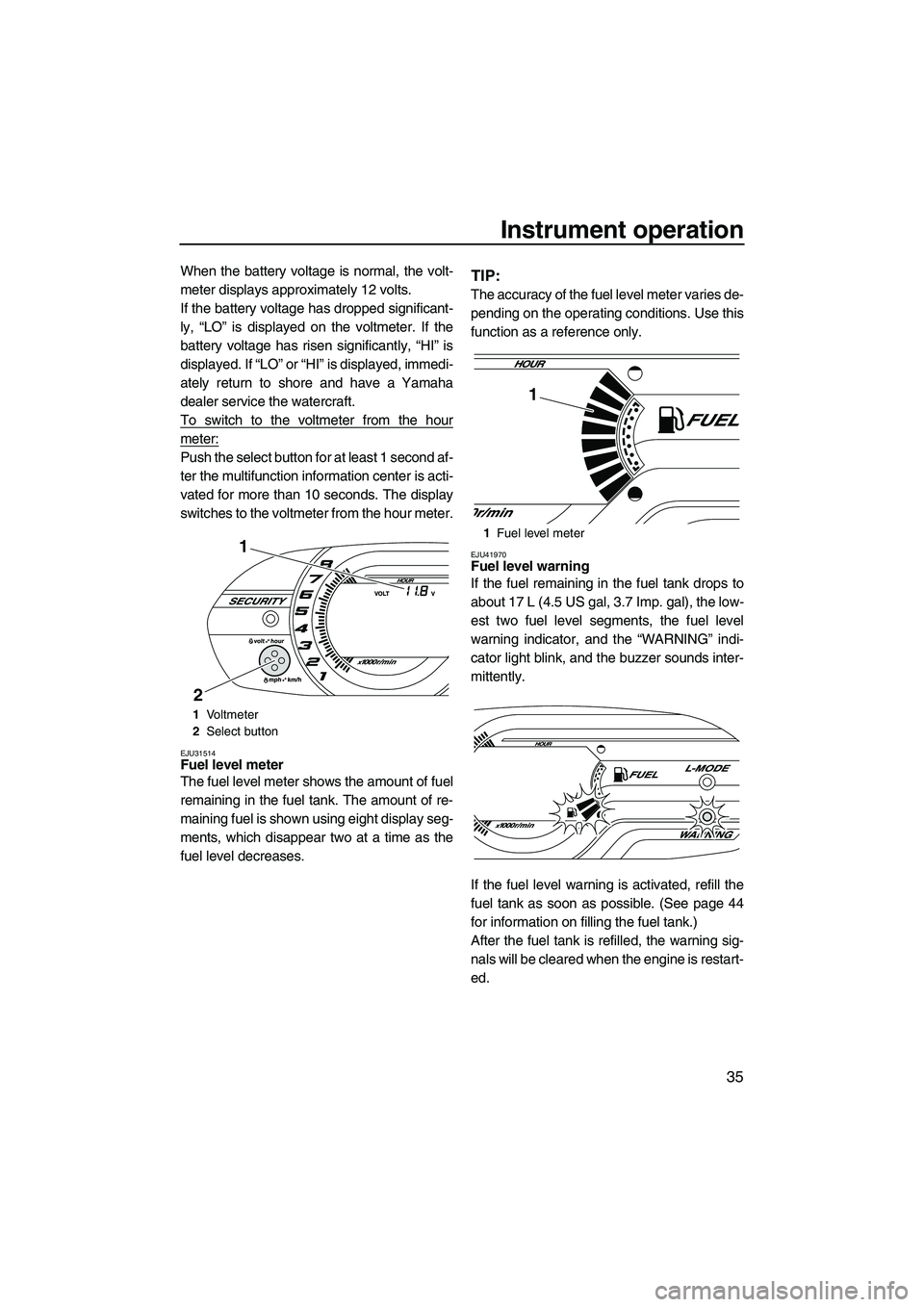
Instrument operation
35
When the battery voltage is normal, the volt-
meter displays approximately 12 volts.
If the battery voltage has dropped significant-
ly, “LO” is displayed on the voltmeter. If the
battery voltage has risen significantly, “HI” is
displayed. If “LO” or “HI” is displayed, immedi-
ately return to shore and have a Yamaha
dealer service the watercraft.
To switch to the voltmeter from the hour
meter:
Push the select button for at least 1 second af-
ter the multifunction information center is acti-
vated for more than 10 seconds. The display
switches to the voltmeter from the hour meter.
EJU31514Fuel level meter
The fuel level meter shows the amount of fuel
remaining in the fuel tank. The amount of re-
maining fuel is shown using eight display seg-
ments, which disappear two at a time as the
fuel level decreases.
TIP:
The accuracy of the fuel level meter varies de-
pending on the operating conditions. Use this
function as a reference only.
EJU41970Fuel level warning
If the fuel remaining in the fuel tank drops to
about 17 L (4.5 US gal, 3.7 Imp. gal), the low-
est two fuel level segments, the fuel level
warning indicator, and the “WARNING” indi-
cator light blink, and the buzzer sounds inter-
mittently.
If the fuel level warning is activated, refill the
fuel tank as soon as possible. (See page 44
for information on filling the fuel tank.)
After the fuel tank is refilled, the warning sig-
nals will be cleared when the engine is restart-
ed.
1Vo l t m e t e r
2Select button
1
2
1Fuel level meter
1
UF2M71E0.book Page 35 Wednesday, June 29, 2011 9:27 AM
Page 95 of 98
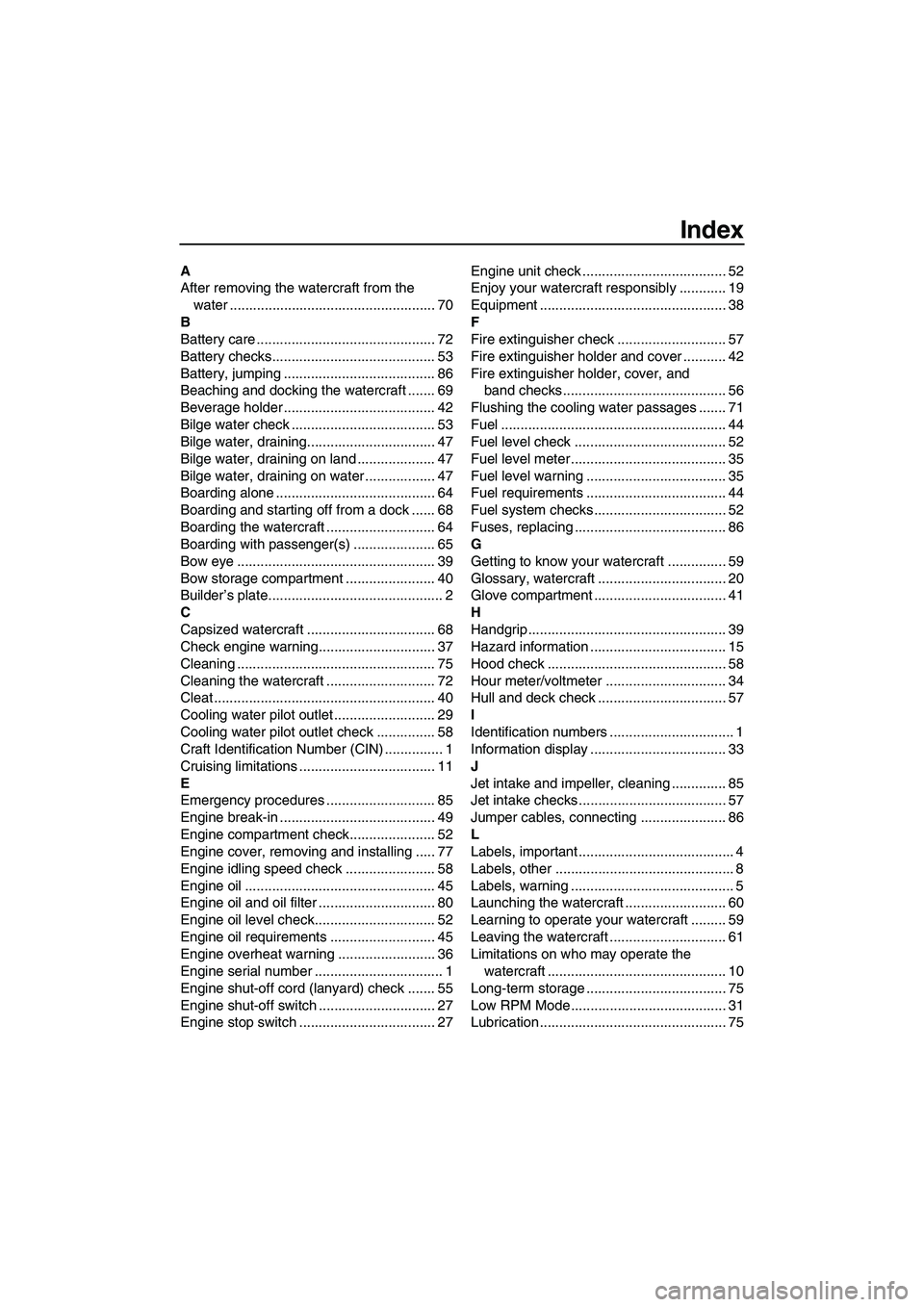
Index
A
After removing the watercraft from the
water ..................................................... 70
B
Battery care .............................................. 72
Battery checks.......................................... 53
Battery, jumping ....................................... 86
Beaching and docking the watercraft ....... 69
Beverage holder ....................................... 42
Bilge water check ..................................... 53
Bilge water, draining................................. 47
Bilge water, draining on land .................... 47
Bilge water, draining on water .................. 47
Boarding alone ......................................... 64
Boarding and starting off from a dock ...... 68
Boarding the watercraft ............................ 64
Boarding with passenger(s) ..................... 65
Bow eye ................................................... 39
Bow storage compartment ....................... 40
Builder’s plate............................................. 2
C
Capsized watercraft ................................. 68
Check engine warning.............................. 37
Cleaning ................................................... 75
Cleaning the watercraft ............................ 72
Cleat ......................................................... 40
Cooling water pilot outlet .......................... 29
Cooling water pilot outlet check ............... 58
Craft Identification Number (CIN) ............... 1
Cruising limitations ................................... 11
E
Emergency procedures ............................ 85
Engine break-in ........................................ 49
Engine compartment check...................... 52
Engine cover, removing and installing ..... 77
Engine idling speed check ....................... 58
Engine oil ................................................. 45
Engine oil and oil filter .............................. 80
Engine oil level check............................... 52
Engine oil requirements ........................... 45
Engine overheat warning ......................... 36
Engine serial number ................................. 1
Engine shut-off cord (lanyard) check ....... 55
Engine shut-off switch .............................. 27
Engine stop switch ................................... 27Engine unit check ..................................... 52
Enjoy your watercraft responsibly ............ 19
Equipment ................................................ 38
F
Fire extinguisher check ............................ 57
Fire extinguisher holder and cover ........... 42
Fire extinguisher holder, cover, and
band checks.......................................... 56
Flushing the cooling water passages ....... 71
Fuel .......................................................... 44
Fuel level check ....................................... 52
Fuel level meter ........................................ 35
Fuel level warning .................................... 35
Fuel requirements .................................... 44
Fuel system checks .................................. 52
Fuses, replacing ....................................... 86
G
Getting to know your watercraft ............... 59
Glossary, watercraft ................................. 20
Glove compartment .................................. 41
H
Handgrip ................................................... 39
Hazard information ................................... 15
Hood check .............................................. 58
Hour meter/voltmeter ............................... 34
Hull and deck check ................................. 57
I
Identification numbers ................................ 1
Information display ................................... 33
J
Jet intake and impeller, cleaning .............. 85
Jet intake checks ...................................... 57
Jumper cables, connecting ...................... 86
L
Labels, important ........................................ 4
Labels, other .............................................. 8
Labels, warning .......................................... 5
Launching the watercraft .......................... 60
Learning to operate your watercraft ......... 59
Leaving the watercraft .............................. 61
Limitations on who may operate the
watercraft .............................................. 10
Long-term storage .................................... 75
Low RPM Mode ........................................ 31
Lubrication................................................ 75
UF2M71E0.book Page 1 Wednesday, June 29, 2011 9:27 AM